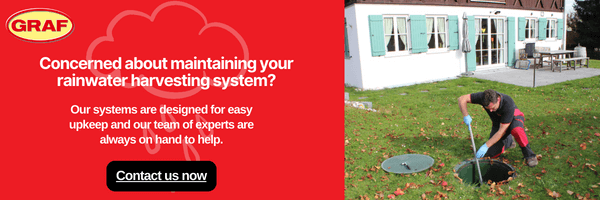Rainwater harvesting systems are a fantastic way of recycling water runoff from the roof of your home so it can be reused in the garden and around the property. To get the most out of the system you need to ensure it is set up property and well maintained, which will help you avoid any unnecessary issues. Here we explain more about the typical problems homeowners experience with a rainwater harvesting system and what you can do to avoid them.
What is rainwater harvesting?
Rainwater harvesting is the process of collecting and storing rainwater runoff for reuse. The system is connected to the roof guttering so during downpours the rain is collected in a large storage unit. Not only does it help with stormwater management and reduce the risk of floods, but the stored water can also be used to flush the toilets, wash the car and for outside garden irrigation purposes, providing a sustainable and cost effective way of lowering your water bills.
What are the common issues with a rainwater harvesting system?
Bad smelling water
If the stored rainwater starts to give off a bad odour it can be caused by a number of different things, such as:
Algae growth
Exposure to sunlight can increase the temperature in the tank which encourages the growth of algae, so it’s important to ensure the tank is always sealed. Use of rain heads, gutter mesh and tank screens will also help to reduce nutrient loads, and if you have existing algae growth, chlorinated water can be used to kill and remove it.
Tank base sediment
Sediment accumulation can also be reduced through the use of rain heads, gutter meshes and tank screens. Using any of these components will help the removal of any dust and organic matter that has made its way into the tank from the roof of the property.
Animals in the tank
Sometimes rodents, birds or frogs can find their way into the tank and begin to decompose if they are no longer alive, which will create a rather strong smell. If this happens, the tank will need to be emptied and fully sterilised before being reused. To avoid this from happening, most rainwater harvesting systems will come with a rodent guard that will stop any rodent or other animal from making their way into the system.
Not collecting enough water
You may notice that your system is not collecting as much water as you expect. This is usually caused by a blockage or leak that needs to be located and remedied for water to pass through into the tank.
In most cases it will simply be leaves or other light debris that is causing the issue, however, large rocks or items may have fallen into the system creating a blockage. It may not always be an easy task to identify where the blockage is taking place or how to remedy it, so you may have to hire a professional company to fix the problem for you.
Unclear water
If you notice that the water in the collection tank is not clear, it could be an indication that there is a problem with the system. In most cases this is a straightforward issue to resolve, as it is usually caused by old, dirty filters that need to be changed. There could also be dirt or debris in the tank that is affecting the quality of the water, or the water may be getting contaminated from another source.
A good way to avoid this happening is to form a regular filter checking and cleaning routine. This ensures the system is being well maintained and water isn’t potentially being wasted. If cleaning the filter does not work, you may want to consider installing a downpipe filter which will clean the water as it leaves the roof and is processed into the tank.
Frost damage
Above ground rainwater harvesting tanks need to be protected against low temperatures to reduce the risk of frost forming. Plastic tanks can expand to allow for the formation of ice, but if this continues to happen over time it can cause damage to the tank.
Naturally, this is more likely to occur during the winter months, so to avoid this happening you may want to consider draining the tank for this period, especially if the water is mainly used for gardening. Alternatively, you could insulate the tank, either by investing in a pre-insulated model, or by buying the appropriate outdoor insulating material to wrap around the tank to maintain a steady temperature.
Water overspill
Living in the UK we are prone to heavy downpours of rain for prolonged periods, so there is a chance the tank can fill up quite quickly, so it reaches its capacity and starts to overflow. This is where the importance of an overflow pipe comes into play as it can effectively direct excess water to the nearest drain.
Most drains are located directly underneath the downpipe so this should be straightforward, although make sure that the overflow pipe is not smaller than the pipe feeding water into the tank. If it is smaller, it will choke the level of water exiting the tank from overflow when the tank is full. Potentially causing the system to flood.
What size rainwater harvesting system should I buy?
To determine the size of system you require, you first need to identify the size of the catchment zone. This encompasses the area of the roof in plan (which will be similar in size to the ground floor). You will also have to find out the expected annual rainfall per m2 for the area where your plot it based, which can vary quite a bit depending on where you live. You can use the Met Office website to find out average values for your area. These two factors determine the yield of the system, i.e. how much rainwater can be captured.
You will also need to factor in how many bedrooms the property has and what the harvested rainwater will be used for, as this determines how much demand is required from the system. Companies have a tank size calculator tool to help with this. Click here to use our calculator.
How much maintenance does a rainwater harvesting system need?
In theory, rainwater harvesting systems do not require very much maintenance beyond ensuring the filtration is performing as it should to prevent leaves and debris from falling into the tank. Some systems do offer self-cleaning options, that periodically jet wash the filter with a shower nozzle which is integrated in to the filter.



